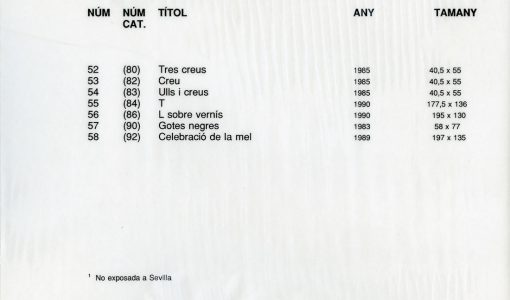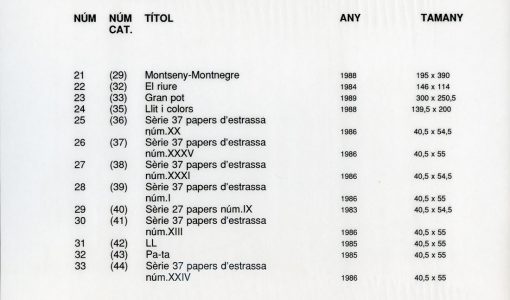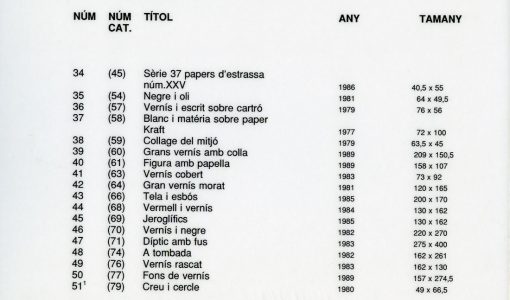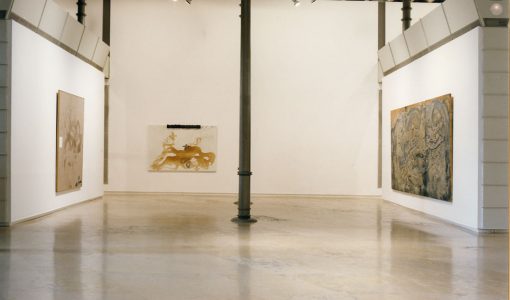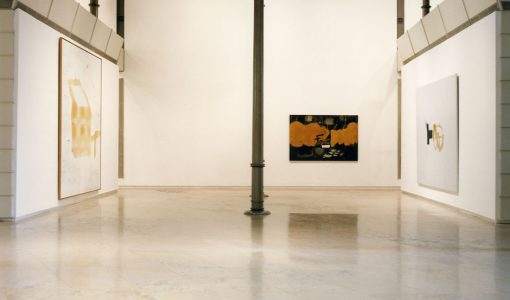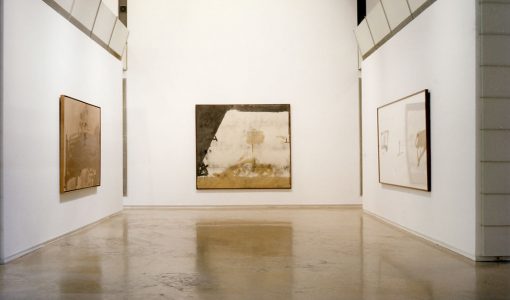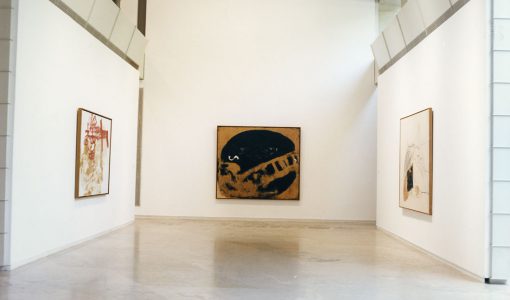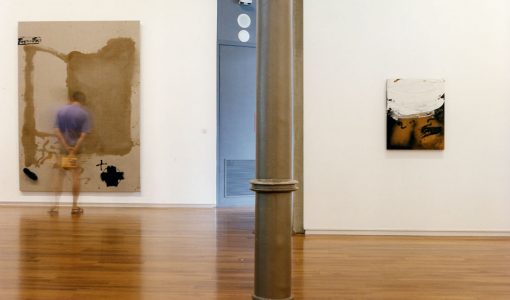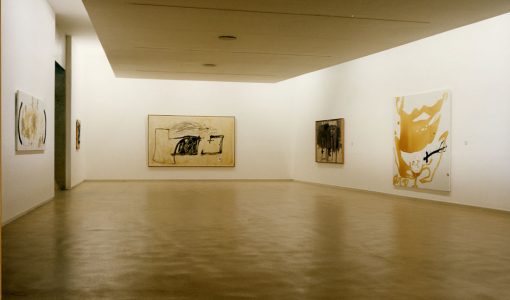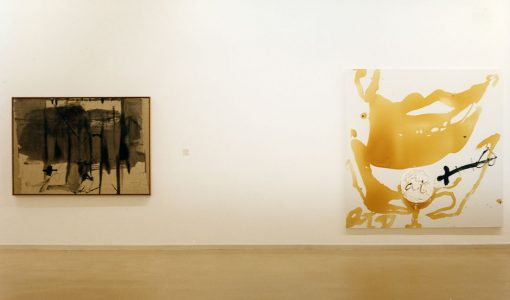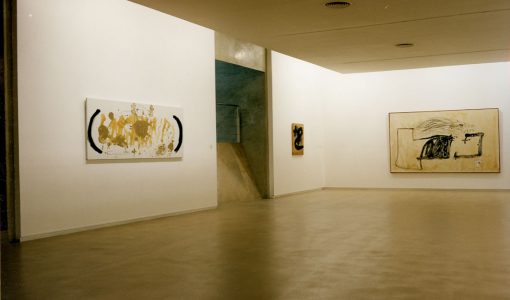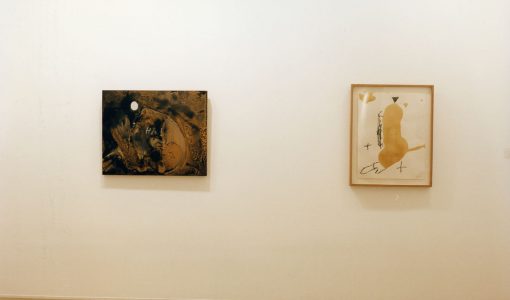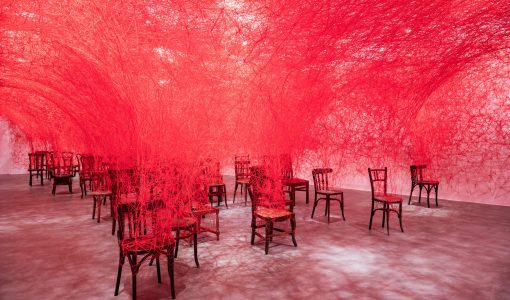
Tàpies. Celebració de la mel
Home
›
Exhibitions
›
Tàpies. Celebració de la mel
Celebració de la mel is a collection of ninety-two works linked together by the artist’s special use of varnish.
Although Tàpies use of varnish dates back to the beginning of his career, he has only been using regularly since the eighties. His varnish paintings reveal a Tàpies who plays with a transparency, disorder and heterogeneity, that is in sharp contrast the opaque quality and compositional rigor of his matter paintings. Varnish, whether applied to large surfaces of paper, canvas or wood, or simply used to hint at almost caligraphic forms, makes his works airy and luminous.
The transparency of varnish hints at the inner world of objects, while the superimposed layers of the material used in some of the works create an impression of movement and power. Varnish is difficult to control, fluid and unpredictable: the artist is subject to the whims of chance.
At no time when I speak of his “varnishes” am I attempting to make a more or less detailed analysis of Tàpies’techniques. Such an analysis would in itself be meaningless. Rather than merely describing or categorizing his work, rather than devising a system of classification that would mask more than reveal his creative process, what I am attempting to do is explore how the varnish paintings fit in with, or depart from the rest of Tàpies’work.
He has made more and more liberal use of varnish in the past decade in response to new needs which he has solved by developing new media of expression. His more systematic use of varnish has made brushstrokes, stains and transparency essential ingredients in his production and opened new perspectives in his aesthetic evolution. It lets Tàpies be surprised while working with a sort of calligraphy that cannot be corrected, and gives his latest work a very definite and distinctive character.
The very nature of the varnishes makes them a genuine form of artistic research into the universal link between all categories, approaches materials and models encompassed by art. In this sense one of Tàpies’most significant works is precisely Celebració de la mel (In praise of Honey, 1989), whose title is a direct reference to one of the oldest and greatest Upanishads. This Upanishad, which Tàpies has obviously read and studied, extols the spiritual identity shared by the subtle essence of the universe and the creatures who compose it. This identity is symbolized by honey, which assimilates all of its cosmic manifestations (earth, water, fire, sun, space …). The Earth is the honey of all beings and humans should respond in kind. In other words, they should recognize in themselves the ingredient that identifies them with the whole. The Upanishad underscores the gentle, dulcet nature of this universal bond:
“Sweet as honey is this Earth for all beings; sweet as honey are beings for this earth. Sweet ashoney is the radiant and immortal One who occupies the cosmos and the radiant and immortal One who inhabits and occupies this body.”
Tàpies’s use of varnish is reminiscent of certain forms of oriental poetry, like haiku. While Wester art and thought transform all impressions into descriptions, haiku never describes. In his work from the sixties and seventies Tàpies revealed objects of his desire, diplaying an anxiety that could only be understood by acknowledging the aestheticism of the objects he depicted. In the varnishes of the eighties, this artistic quality, this elegance of style, has become the core of his painting which, like haiku, has the purity, the roundness, the very isolated quality of a musical note. Buddhist poets used haiku to attack the symbol as a semantic operation. Likewise, in the varnishes Tàpies has discovered a sort of “a-language”, free of description and the restraints of symbolism.
From Western rationalist idealism we have inherited the tendency to believe that objects and beings have an interior and an exterior and that the latter gives a deceptive idea of the former. We tend to think that excessive formalism hides the interior of things, and the interior is what we believe to be important. This explains why some critics have not hesitated to express their reservations about a kind of art they find excessively gentle and pleasant. Nevertheless, the “pleasantness” of Tàpies’recent work does not guard a hidden “meaning” that differs from what it appears to be on the surface. On the contrary, it is a manifestation of the brushstroke, which does not express but simply reveals itself and, like the Japanese bows of greeting, has no meaning beyond that of the gesture itself. What Tàpies proposes in his varnishes is a vacuum through which he aims to achieve what Zen describes as satori, a suspension of language and codes that constitutes the true expression of our inner selves.
Galeria d'imatges
Dates
29.06.1993 – 05.09.1993
Curator
Manuel J. Borja-Villel.
Artist
Antoni Tàpies.
Touring
19/7/1991 – 1/9/1991, Centro Atlántico de Arte Moderno, Las Palmas de Gran Canaria.
10/10/1991 – 24/11/1991, Fundação Serralves, Museu de Arte Contemporânea, Oporto.
19/12/1991 – 26/1/1992, Centro de Arte Moderna, Fundação Calouste Gulbenkian, Lisbon.
12/3/1992 – 10/5/1992, Pabellón Mudéjar, Seville.
5/6/1992 – 20/9/1992, Kunstverein St. Gallen Kunstmuseum, St. Gallen.
29/6/1993 – 5/9/1993, Fundació Antoni Tàpies, Barcelona.
6/10/1993 – 3/12/1992, Sala Rekalde, Bilbao.
